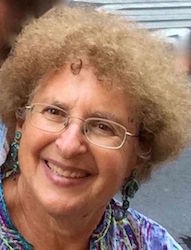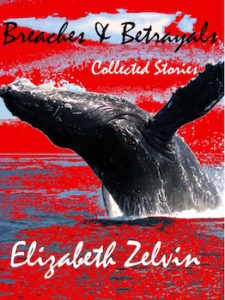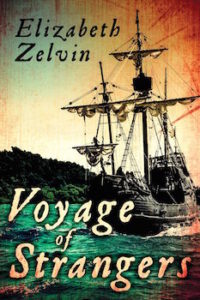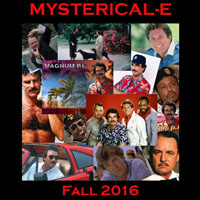Tell us a little about your books. How many have you written, a short look at your protagonist(s), major themes, etc.
The Bruce Kohler mystery series consists of four novels, starting with Death Will Get You Sober, a novella, and five published short stories. Two of the stories were nominated for the Agatha and one for the Derringer Award for Best Short Story. A sixth Bruce story has been accepted by Ellery Queen’s Mystery Magazine and the seventh is slated for the next Murder New York Style anthology from Sisters in Crime New York. Bruce is a recovering alcoholic with a smart mouth, a New York attitude, and an ill-concealed heart of gold. On the surface, he starts investigating murders to keep from dying of boredom in sobriety, but it’s really because when he stops drinking, he starts becoming mentally and emotionally engaged for the first time in years. He also gets a second chance at two friendships his drinking destroyed. Barbara, a world-class codependent who’s addicted to minding other people’s business, and her boyfriend Jimmy, a computer geek and history buff who loves AA and hates leaving Manhattan, become his sidekicks. The themes of the series are recovery from alcoholism, addictions, and codependency and, more broadly, growing up, which can happen at any age and never really stops.
My other series, the Mendoza family saga, is historical fiction rather than mystery, but, paradoxically, it starts with two short stories that were published in Ellery Queen’s Mystery Magazine. The first one, “The Green Cross,” was definitely a mystery; it was also nominated for an Agatha. The second, “Navidad,” eventually became the prologue of the first novel, Voyage of Strangers, which told the story of what really happened when Columbus discovered America from the point of view of a young Jewish sailor, Diego Mendoza. Diego was the original protagonist, who sailed with Columbus in 1492 on the same day the Jews were expelled from Spain. But in the novels, he shares the spotlight with his sister Rachel, who manages to wangle her way aboard on the second voyage, which is when the genocide of the indigenous Taino in the Caribbean took place. And in the sequel, Journey of Strangers, which takes Diego and Rachel to the Ottoman Empire, there is a second plotline based on history. Joanna, its protagonist, is one of 2,000 Jewish children abducted by the King of Portugal in 1493 and sent as slaves to work the sugar plantations on the island of São Tomé off the coast of West Africa. You could argue that there are plenty of crimes in these novels as well. The themes are intolerance, bigotry, and absolutism vs cultural relativism and the outsider perspective.
I have an e-collection of standalone short stories that originally appeared here in Mysterical-E and other e-zines or in EQMM, AHMM, and various anthologies. It’s called Breaches and Betrayals.
Finally, I have a series of mystery stories featuring a nice Jewish country music artist, Amy Greenstein, aka Emerald Love, who’s a shapeshifter. I’m told the moment isn’t quite right for a novel about Emerald. If I were already a bestseller in urban fantasy mystery…if I were writing her for Young Adults…In the meantime, “Shifting Is for the Goyim” and a few other stories (including a couple about Amy’s mother, set in the 1950s) are out there. The themes are much the same as in the rest of my work: Being different shouldn’t matter. Love does.
What inspires you to write?
I’ve always wanted to be a writer, at least since I was seven years old, which is about a hundred years ago. But unlike a lot of writers who say they feel driven to write, if you locked me up in a dungeon like the Count of Monte Cristo with a candle and a pen and no chance of getting out, I don’t think I’d still feel impelled to write. I’m inspired to write when I have something to say–and I usually do.
How have you grown as a writer, what would you say has improved most in your writing?
I’m not sure whether to say pace or killing my darlings. In fact, I think they’re flip sides of the same coin. I was at an extended workshop, working on the manuscript of what became my second published book–the sixth or seventh novel I’d written up to that point in my life–and the workshop leader said, “Liz, in your case, less is more. You only need to say two clever things per paragraph, not three or four.” All of a sudden, the “darlings” I needed to “kill” started leaping up from the page at me, and it’s kept happening ever since. It’s amazing how being able to cut things out picks up the pace of the narrative. I put everything I think into the first draft, and then if I delete six thousand words, it doesn’t bother me one bit. I think before, I was always afraid if I didn’t use everything, there would be no more where that came from. Now I trust the well not to run dry.
What is the hardest part of writing for you?
Plotting is the tough part for me. Creating characters, setting them in motion and in relation to each other–I was going to say, writing dialogue, but in fact, my series characters can start talking in my head any time, all I have to do is get to a keyboard or a voice recorder or grab a pen and paper and write it down–all that is sheer joy. I love mysteries, but The Puzzle does not come naturally. The easiest book for me to plot was Voyage of Strangers, the Columbus book, because half the characters came from history, and every major incident, even the most outrageous, actually happened. I simply wove my fictional characters into the story.
How important is research for your writing?
I did almost no research for the Bruce Kohler books. They’re set in New York, where I’ve lived my whole life, and my “other hat” is a social worker, psychotherapist, and addiction treatment professional. In the 1990s I directed an alcohol treatment program on the Bowery that in some ways resembled the one where Bruce gets sober–though that Bowery, the one with the bars and flophouses, was almost gone then and has completely vanished now. I did go out in a boat on Gardiners Bay and learn how to cast for bluefish for a crucial scene in Death Will Extend Your Vacation, the book in which Bruce and his friends take shares in a clean and sober group house in the Hamptons and find a body on the beach on their first day. But having avoided any kind of research like the plague my whole life, I began a late-life love affair with it the morning after Diego’s voice came knocking on the inside of my head one night, demanding I tell his story. I looked up Columbus on the Internet, found excerpts from his own log of the first voyage (he lied about his calculations so the sailors wouldn’t get discouraged, but that only makes the story more interesting), and I was hooked. The best part is finding fascinating nuggets that almost nobody knows, like those 2,000 Jewish children who were snatched from their parents on the Lisbon docks. Another one I used in Journey of Strangers: in the Ottoman Empire in the 16th and 17th centuries, Jewish women called kiras served as purveyors to the women of the Sultan’s harem, bringing in goods and services and carrying out commissions in the outside world–you could think of them as personal shoppers to the Sultan’s ladies. That’s how I got Rachel into the harem.
Can you recall an incident while you were doing research that stands out as frightening or funny?
The funniest one that springs to mind is a consequence of not having done research. At least, I think it’s funny. I have to explain the background first. My husband and I both have a lot of responsibility in our lives, so we allow ourselves a few areas of sheer silliness, and one of these is endowing our collection of stuffed animals with personalities. Most of them are obsessed with food: the bears’ solution for any problem is “Put a salmon in it,” and the moose likes to graze on moose moss (a green carpet). This is part of our family mythology, and I didn’t think twice about it when I had Bruce talk about how he’d literally cleaned up his act after getting sober by reorganizing his apartment in the following words:
The boxes of possessions that had stuck to me like moss the last few years of my drinking were gone. Some stuff had ended up in the worthy-cause thrift shop on the corner, the rest in the nearest Dumpster. I didn’t miss any of it. I’m not a moose. I don’t need moss.
Now I have to explain that my husband is not one of those spouses who reads every draft and catches every typo. He reads my work when it’s published and not a second before. The passage above appears early in Death Will Help You Leave Him, which came out while I was attending Bouchercon in Indianapolis. He’d been left with strict instructions to read the book, so when he called, my first question was, “Did you read it?” I didn’t expect him to crack up. “What?” I said. “Why are you laughing?” He was laughing too hard to speak. “Tell me!” I said. “What is it?” Between howls of laughter, he finally managed to gasp out, “Moose don’t eat moss!” “What do you mean? Of course they do. Our moose talks about it all the time.” “It was a joke,” he said, still laughing so hard I was afraid he’d have a heart attack. “I got it from Dr. Seuss!”
Which is more difficult to write: the “good guys” or the villains?
This question doesn’t speak to me, probably because I don’t build my characters in a calculated way. My ongoing series characters have a life of their own. They’re easy to write because they themselves do all the work. All I have to do is set them free. The secondary characters, some of whom will turn out to be the villains, spring up to populate the story as I tell it going forward. I’ve tried it the other way, planning in advance, and it’s no use–they turn out completely lifeless. I’ve had the experience of changing whodunit in midstream a couple of times. More often, the motive for the murder has turned out to be different from what I thought it was. Especially when the villain is a woman, in the climactic scene, when she gets to speak for herself, she has more than once proved to be more sympathetic–or at least more understandable–than I expected.
Some writers create a bubble around themselves until they’re finished with their project – how true is that in your case?
I can’t imagine how anyone with a 21st century life would achieve that. I build a bubble around myself when I sit down to write, in the sense that I have to be alone. I am baffled by writers who can work on their novels in Starbucks. Even my husband stopping as he crosses the room can distract me. “You’re breathing,” I say. Luckily for me, he has a day job and I have a country retreat in the summer where I can have a 24-hour-bubble if I want. But sometimes I’m perfectly happy to make it a thousand-word bubble and an afternoon at the beach.
What factors, other than characters, play an important role in your books, e.g. the weather, music, locale (city, country, suburbs)?
In the Bruce books, the New York City setting is very important: the energy, the million little worlds that you might discover or intersect with any time. So is the hidden and fascinating world of recovery, the network of Alcoholics Anonymous and the 12-step programs. My original motivation for writing these books was to show people who aren’t just not drinking but living through this amazing transformative process and even having fun. When I started, the great recovering alcoholic crime fiction protagonists were Lawrence Block’s Matt Scudder and James Lee Burke’s Dave Robichaux, and they were both pretty dark. If you watch the TV series Mom with Allison Janney–nobody was doing that with recovery back then.
What is special about the mystery genre for you as a writer?
I’ve loved mysteries ever since someone recommended I read Dorothy L. Sayers’s Murder Must Advertise while I was working at the J. Walter Thompson ad agency after graduating college with honors in English and American lit. That was the end of literary fiction for me. In our genre, it’s guaranteed that something will happen! I used to say that the mystery is like a sturdy coat hanger on which the writer can hang anything she or he wants, whether it’s English bell ringing or illegal puppy smuggling or art forgery or recovery from alcoholism. Today, it’s gotten a little more complicated–the simple structure of crime, investigation, and solution is not enough. We need suspense, we need conflict and confrontation, we need personal danger for the protagonist even in the detective story. And as a short story writer, though not as a novelist, I’ve explored the joys of writing crime fiction from the point of view of characters who are not necessarily the good guy, or at least morally ambivalent. I may never write a male killer POV, but a woman? Oh, that is fun. There’s enormous scope in mystery and crime fiction for a writer to stretch in all sorts of ways.
Why do you think readers are fascinated by mysteries?
The stock answer is because wrongs are righted. I’d also say: because something always happens.
Outside the type of mystery you write, which mystery sub-genres do you enjoy most?
I love any kind of character-driven crime fiction if the characters and their relationships have depth and authenticity and if at least one of them is likable–preferably endearing. That includes police procedurals, private eye series, related professionals like lawyers, journalists, even clergy, as well as suspense, historical mysteries, and cross-genre crime fiction mixed with urban fantasy or speculative fiction.
Do you have favorites among the characters you have created?
I love how sardonic Bruce can be without for a second losing that big heart that he almost lost to the booze, and I like how honest he is about his own reactions to this corny AA stuff that actually works. I love Barbara because she started out as a nice Jewish girl from Queens (like me), but (unlike me) she has no boundaries and no brakes. I’ve had loads of fun taking her over the top. Some readers love her and some find her annoying. One reader came up to me, I think at Malice, and said, “Has anyone else told you they felt like giving Barbara a smack?” My very favorite might be Rachel Mendoza. She wasn’t meant to be a POV character, but she’s so forthright and spirited and generous and big-hearted. The Inquisition be damned, nobody is going to stop her from taking a Rom girl or a Moorish slave boy under her wing, and that’s at the beginning, when she’s just a reckless kid without the maturity and wisdom she acquires along the way. Everyone falls in love with Rachel, in both her world and ours.
Which of your characters could you share an apartment with?
Hmm. None of them is exactly the domestic type, so they wouldn’t be offering to do my laundry. On the other hand, they wouldn’t expect me to do their laundry either. Bruce does find a clue at the laundromat in “Death Will Tie Your Kangaroo Down,” but the dead Australian who left it dropped the laundry off himself.
Which characters could you not live with?
Barbara might be a problem, considering that in some ways she’s a lot like me. We’d be bumping into one another talking with our hands, interrupting, and finishing each other’s sentences.
What books have influenced your life the most?
I always say that the books that made me a writer were Little Women, Emily of New Moon by L.M. Montgomery (better known for Anne of Green Gables), and the Diary of Anne Frank. My conversion from literary to genre fiction came from my discovery of Dorothy L. Sayers, as I said. Since I’m still a champion of genre fiction half a century later, that obviously had a profound impact.
Who are the authors you admire most, or who inspire you?
What other genres do you enjoy reading?
I’m going to answer these two questions together because my two very favorite authors are not mystery or crime fiction authors, though both are brilliant at mixing genres. Besides brilliant writing and plotting, both write characters to die for: protagonists you fall in love with, families and circles of friends you want to take home with you, secondary characters you never mix up and never forget, no matter how minor their part in the story. At the top of my list is Lois McMaster Bujold, the author of the Vorkosigan saga. She takes speculative fiction–space opera, hard science, and future sociology–to the limit and mixes it, depending on the novel, with mystery, thriller, romance, caper, and even comedy of manners. And coming in second is Diana Gabaldon, author of the Outlander series, who sweeps the reader away into the eighteenth century and never lets up. Time travel romance is a pallid name for the rich brew of adventure, passion, and personality she puts into an exquisitely rendered historical setting brimming with action. I had read the first book, Outlander, three times before I noticed a brief incident that in any other author’s hands would have been the climax of the book: while escaping from Wentworth Castle, Claire, the heroine, kills a wolf with her bare hands. In Gabaldon’s hands, the reader suspends disbelief.
Of favorite books you have read, which is the one you keep going back to again and again?
If I have to pick one, it’s Little Women. Besides the portrait of Jo as the quintessential writer and the fact that I still cry every time Beth dies, I believe this is as much the Great American Novel as Huckleberry Finn, unacknowledged only because it was written by a woman for girls and women. Its plain diction and depiction of ordinary girls going about their everyday lives was extraordinary in its day, and it is still not only in print but being widely read for pleasure 150 years later, unlike any other novel of its time that I can think of. Huck Finn holds up well: it was still funny when I read it aloud to my son a few decades ago–but how often is it read outside the classroom? I believe mothers are still buying Little Women for their daughters. I’ve given it to my granddaughters.
If we stick to mysteries, There are a few I’ve read so many times I almost know them by heart: Dorothy L. Sayers’s Gaudy Night and Josephine Tey’s Brat Farrar are among the most beloved mysteries, not only for me but for many readers. I’ll re-read whole series of a favorite author: Donna Leon, Margaret Maron, Julia Spencer-Fleming, Marcia Muller, Deborah Crombie, Laurie R. King, Reginald Hill, Cynthia Harrod-Eagles, Nevada Barr, Dana Stabenow.








